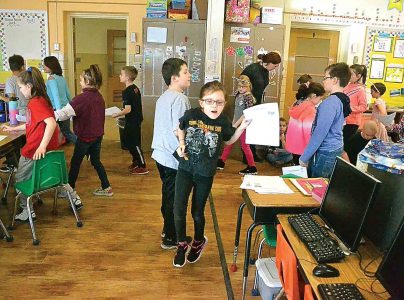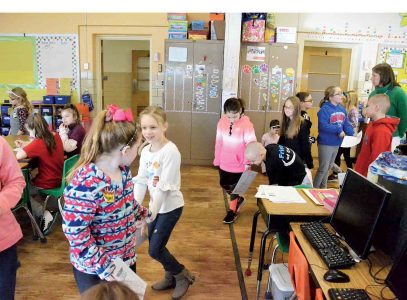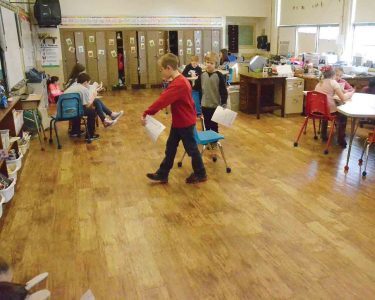Harmar Elementary embraces co-teaching with third grade
- Students pair off for a reading exercise Monday in the third grade class co-taught by Alyson Tornes and Courtenay Halliday at Harmar Elementary School. The wall dividing the two classrooms was removed during the holiday break.
- Students pair off for a reading exercise Monday in the third grade class co-taught by Alyson Tornes and Courtenay Halliday (shown at right talking to students) with the assistance of intervention specialist Earlene Watson at Harmar Elementary School. The wall dividing the two classrooms was removed during the holiday break.
- Students rearrange chairs for a reading exercise in the third grade classroom at Harmar Elementary School Monday morning. During the holidays the wall dividing two of the school’s second floor classrooms was removed, creating a single big space for all the third graders.
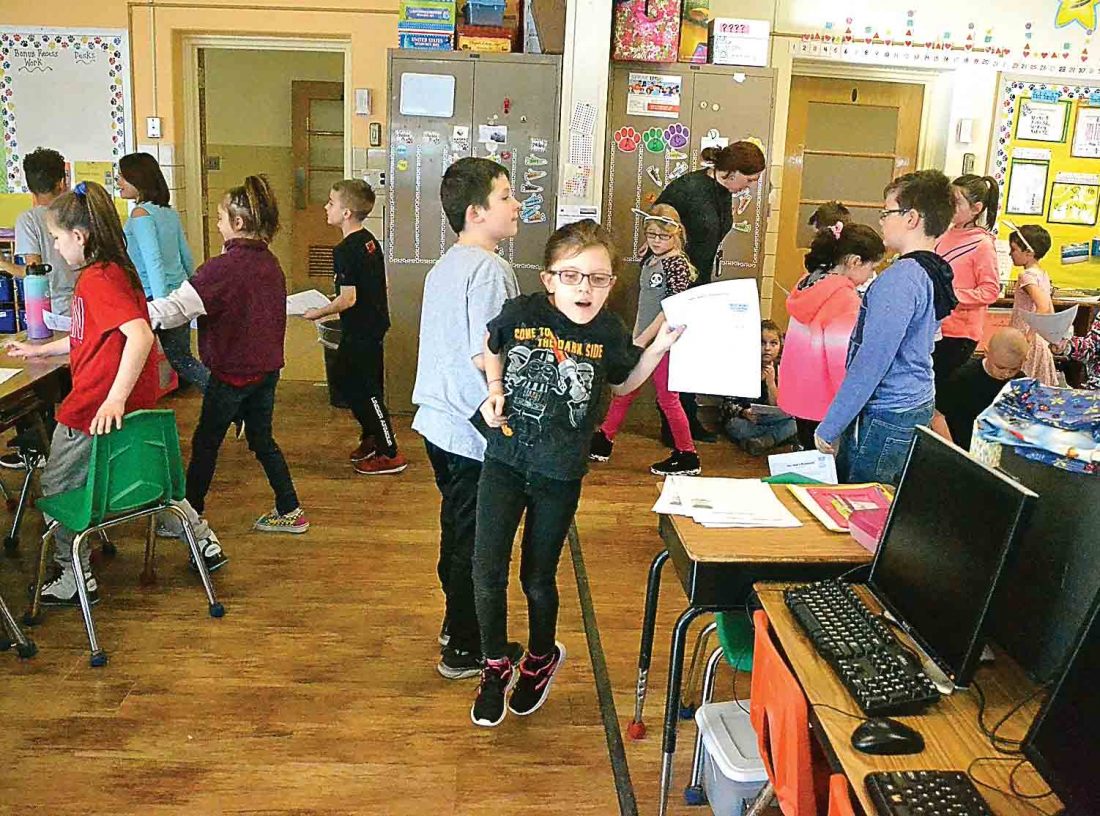
Students pair off for a reading exercise Monday in the third grade class co-taught by Alyson Tornes and Courtenay Halliday at Harmar Elementary School. The wall dividing the two classrooms was removed during the holiday break.
MARIETTA — The third-grade students at Harmar Elementary School returned to class Monday after the holiday break to find a drastically changed environment.
During the break, district maintenance crews removed the wall dividing the school’s third grade classrooms, creating a single big space on the second floor.
The third-grade students have operated as a single class at Harmar for several years, said teachers Courtenay Halliday and Alyson Tornes, but until now had been taught in adjacent but divided classrooms, shuttling back and forth depending on what sort of space and resource arrangement was required.
“We started co-teaching about seven or eight years ago,” Tornes, who has been teaching for 24 years, said. “It’s three teachers at each level,” with two classroom teachers and an intervention specialist assigned to each grade.
The combined third grade class includes 46 students, she said.
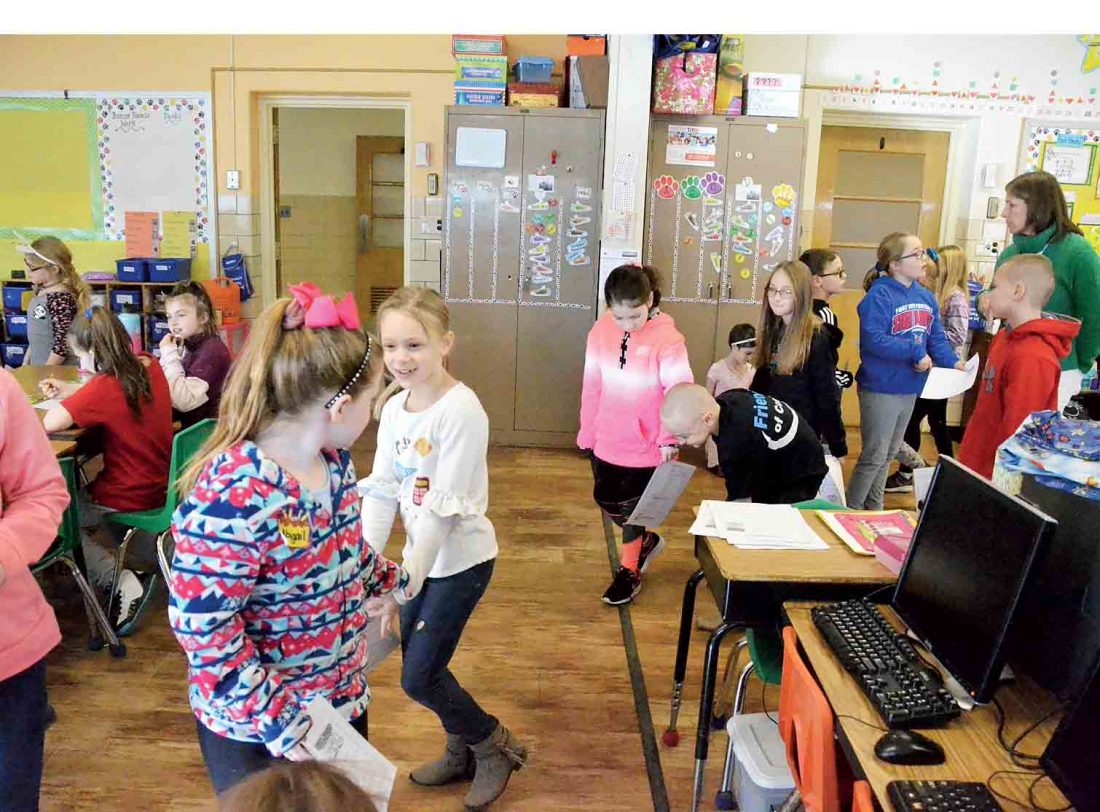
Students pair off for a reading exercise Monday in the third grade class co-taught by Alyson Tornes and Courtenay Halliday (shown at right talking to students) with the assistance of intervention specialist Earlene Watson at Harmar Elementary School. The wall dividing the two classrooms was removed during the holiday break.
The advantages of co-teaching, which intervention specialist Earlene Watson said has become the model in most teaching colleges, are numerous.
“It’s more conducive to differentiating students by their abilities. Without the wall, we can pull kids aside as we need to for additional help, and it’s also better for arranging small groups,” Tornes said.
The combined classes also eliminate duplication in resource materials, such as calendars and curriculum references, she said.
Students, Tornes said, get a less crowded space to learn in and a bigger classroom community, as well as exposure to a greater variety of teaching styles and attention of a different sort from teachers.
“Teachers have different strengths in subject matter and classroom style. And we can give them individual attention in a different way – you see so much more when you’re not in front of the classroom,” Tornes said.
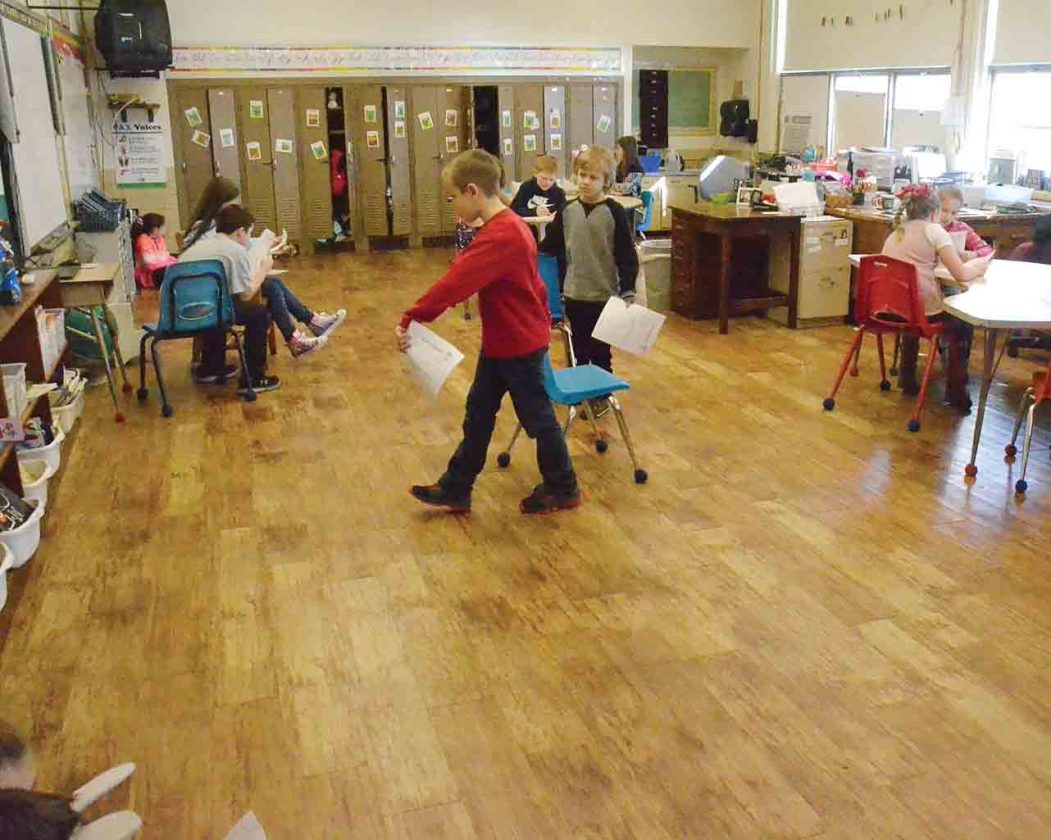
Students rearrange chairs for a reading exercise in the third grade classroom at Harmar Elementary School Monday morning. During the holidays the wall dividing two of the school’s second floor classrooms was removed, creating a single big space for all the third graders.
“You have better opportunities to separate kids who need help,” Halliday said.
“It’s not as noticeable when kids get that individual attention,” Watson said.
The advantages of having a teaching team rather than a single teacher become especially evident when a substitute is required.
“With one of the teachers still in the class, it’s much more consistent when we have subs, and it’s especially important with the shortage of substitutes we have now,” Tornes said. “We can even continue classes without a sub if we need to.”
The big room overlooking the Ohio River was set up on one side with a few rows of desks, and on the other with open spaces and a few chairs. A black stripe on the floor was all that remained of the wall that previously divided the two rooms. In the center of the room, a cluster of eight computer stations straddled the line.
When the students were seated after their lunch break, Tornes described the coming lesson, then brought them to the opposite end of the room and gave them instructions for paired reading.
“You can read separately, you can popcorn read and pop the reading from one to another, you can choral read together, one of you can read and the other can listen, however you want to do it,” she said, and told them to pair off and pick up copies of the reading assignment. Children got up, found partners and moved to whatever area they liked, some at desks, others sliding chairs into corners, others simply sitting cross-legged on a patch of floor.
Although the children had been advised before Christmas break that the wall was coming down, it was still a startling change.
“I was very, very surprised,” said student Carson Prunty. “I had a picture of what it might look like, sort of a sliding door, but it’s huge, like almost the size of the gym. It’s so much bigger, I like it, it’s just … wow.”
“I had forgotten about it,” said student Ryker Gibeaut. “I went in and looked for the lunch menu, it’s usually stuck on the wall, and the wall wasn’t there. I almost fell over. It changed everything, it’s all in different places now.”
Harmar principal Cheryl Cook, who has decades of education experience, said co-teaching or team teaching, far from being something new, has a long history and has enjoyed a recent resurgence. That history is even reflected in physical changes at Harmar.
“Back when team teaching was becoming a big deal, the walls (in some classrooms at Harmar) were removed, but after a period of years they decided they didn’t want to do that any more, so the walls were put back up,” she said.
Cook said Halliday and Tornes came to her during the summer, equipped with a massive set of arguments to support their proposal to take out the wall.
“They had this long list of reason why they should do this, and I told them I thought it was a great idea. I think they were kind of surprised,” she said.
The two, with Watson, were already using team teaching methods, she said.
“They already were co-teaching, the desks were set in one classroom, the other had open areas, they were going back and forth, so without the wall it’s not as confined, you get a better flow, it’s fitting the space to what they already were doing,” she said.
Co-teaching as a common practice originated in the 1960s when parents of children with special needs pressed for their children to be mainstreamed into ordinary classes rather than being segregated. Teachers met that challenge by having special education teachers and aides integrated into classrooms with their students. The concept gradually became broader as educators realized the benefits of having more than one professional adult working with classes.
Cook said the idea has gone through cycles, and the wall that was removed on the second floor had been removed and installed again over the years.
“Teachers all over the district are using these strategies,” she said.
Michael Kelly can be reached at mkelly@mariettatimes.com.

